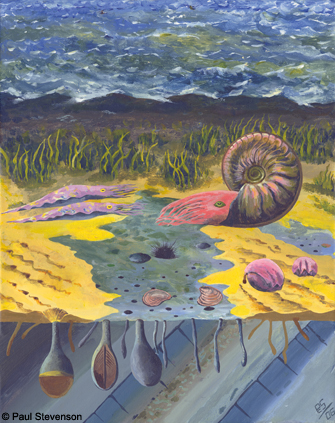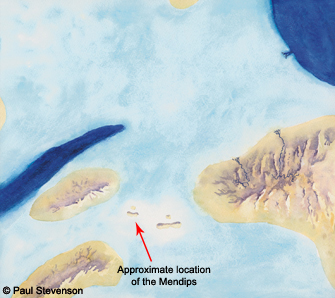
Ancient environments
Silurian l Devonian l Carboniferous l Triassic l Jurassic
The Early to Mid Jurassic, 200 – 161 million years ago

At the dawn of the Jurassic, Britain was between 30° and 40° north of the Equator, with annual temperatures of 12–29°C. Across southern England there was general expansion and deepening of marine conditions, the Mendips forming part of a string of islands that stretched westwards into South Wales.
The Early Jurassic seas teemed with life, particularly ammonites, belemnites and marine reptiles. Usually the rocks in which the fossilised remains of these creatures occur are dark mudstones or thin limestones, but in the Mendips, beds of rubbly limestone occur (e.g. Viaduct Quarry, near Shepton Mallet). This limestone formed in the current-swept waters close to the shoreline of the Mendip islands, and contains the fossilised remains of coarse-ribbed bivalves that were adapted to life in turbulent waters.
Some parts of the Mendips were flooded by the Lower Jurassic sea, such as the Milton area, near Wells. Here, in quieter water conditions, thin limestones and shales were formed. A diverse assortment of fossils also occurs, including bivalves, gastropods, crinoids and occasional ammonites. Some beds contain the remains of fossilised ripples, showing that the sea must have been quite shallow.
By the end of the Lower Jurassic it is likely that most of the Mendips were finally submerged beneath the sea. Initially erosion occurred, as powerful currents scoured the Carboniferous Limestone that formed much of the former land-area of the Mendips. This rocky sea floor became encrusted with oysters and bored into by marine organisms.

At Vallis Vale, near Frome, the erosion surface is remarkably flat, and cuts across steeply dipping Carboniferous Limestone. The Middle Jurassic rocks above this surface, known as the Inferior Oolite, are 170 million years younger than the Carboniferous Limestone beneath. This huge time break is known as an unconformity.
The sea covering the Mendips remained shallow in the early Middle Jurassic, and periodic erosion continued to affect the deposition of the limestones of the Inferior Oolite, At Doulting, near Shepton Mallet, horizons of yellow-stained pebbles, concentrations of oysters and borings made by the bivalve Lithophaga mark levels where sediment accumulation was interrupted.
The geological history of the Mendips for the remainder of the Jurassic and the following Cretaceous Period is poorly known, as any rocks that formed during this time have since been removed by erosion.
It is assumed that the region was deeply buried beneath marine sediments, with a brief return to land in the Early Cretaceous. The final exposure of the Mendip Hills from beneath the mask of younger rocks has probably only occurred within the last few million years.
- Home
- Overview maps
- Locality
areas
- Cheddar Gorge
- Charterhouse
- Blackdown
- Burrington Combe
- Shipham & Rowberrow
- Crook Peak & Axbridge
- Banwell to Churchill
- Priddy
- Harptree & Smitham Hill
- Draycott & Westbury-sub-Mendip
- Wookey Hole & Ebbor Gorge
- Wells
- Great Elm & Vallis Vale
- Mells & the Wadbury Valley
- The Vobster area
- The Whatley area
- Torr Works & Asham Wood
- Beacon Hill
- Stoke St Michael & Oakhill
- Holwell & Nunney
- Shepton Mallet & Maesbury
- Gurney Slade & Emborough
- The Nettlebridge valley
- Geology
- Minerals and mines
- Quarrying
- Caves and karst
- Biodiversity
- Detailed site information
- Acknowledgements
- External links
- Search
- Site map